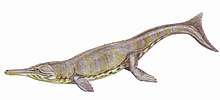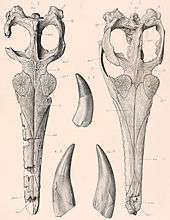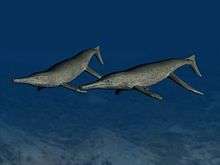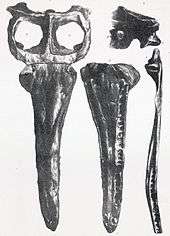Metriorhynchus
Metriorhynchus is an extinct genus of marine crocodyliform that lived in the oceans during the Middle to Late Jurassic. Metriorhynchus was named by the German palaeontologist Christian von Meyer in 1830.[1] Metriorhynchus was a carnivore that spent much, if not all, its life out at sea. No Metriorhynchus eggs or nests have been discovered, so little is known of the reptile's life cycle, unlike other large marine reptiles of the Mesozoic, such as plesiosaurs or ichthyosaurs which are known to have given birth to live young out at sea. Where Metriorhynchus mated, whether on land or at sea, is currently unknown. The name Metriorhynchus means "Moderate snout", and is derived from the Greek Metrio- ("moderate") and -rhynchos ("snout").
| Metriorhynchus | |
|---|---|
| M. superciliosus, Senckenberg Museum of Frankfurt | |
| Scientific classification | |
| Kingdom: | Animalia |
| Phylum: | Chordata |
| Class: | Reptilia |
| Suborder: | †Thalattosuchia |
| Family: | †Metriorhynchidae |
| Subfamily: | †Metriorhynchinae |
| Genus: | †Metriorhynchus von Meyer, 1830 [1] |
| Species | |
| |
Discovery and species
Fossil specimens referrable to Metriorhynchus are known from Middle-Late Jurassic deposits of England, France and Germany.[2]
Valid species

Only two valid species are recognized today, the type species M. geoffroyi and M. superciliosus. "Metriorhynchus" hastifer and "M." palpebrosus are generically distinct from the Metriorhynchus type species, with hastifer being recovered as a geosaurine.[3][4] Species in this genus were traditionally classed into two skull groups: longirostrine (long, narrow jaws) and brevirostrine (short, broad jaws). However, all brevirostrine species have been transferred to the genera Purranisaurus and Suchodus.[5][6]
Eudes-Deslongchamps (1867–69) recognized four Callovian species of Metriorhynchus, M. superciliosus, M. moreli, M. blainvillei, and M. brachyrhynchus.[7] Later, Andrews (1913) considered there to be seven valid species: M. superciliosus, M. moreli, M. brachyrhynchus, M. durobrivensis, M. cultridens, M. leedsi and M. laeve.[8] However, Adams-Tresman (1987), using linear morphometrics, could only distinguish between the two skull groups, so she found there to be two species from the Oxford Clay, M. superciliosus and M. brachyrhynchus.[9] Vignaud (1997) however, considered there to be three Callovian species: M. superciliosus, M. brachyrhynchus and M. leedsi.[10]
Taxonomy and phylogeny

The genera Purranisaurus and Suchodus have been considered junior synonyms of Metriorhynchus,[2] Recent phylogenetic analyses however, do not support the monophyly of Metriorhynchus.[14][15][16] Some of the longirostrine forms, however, do appear to form a natural group.[14][16][17]
The cladogram presented below follows an analysis by Mark Young and Marco Brandalise de Andrade, published in November 2009.[13]
| Metriorhynchus |
| ||||||||||||||||||||||||
Cladogram after Cau & Fanti (2010).[18]
| Metriorhynchus |
| ||||||||||||||||||
Palaeobiology
Description

Averaging 3 metres (9.8 ft) in length, Metriorhynchus was of a similar size to modern crocodiles. However, it had a streamlined body and a finned tail, making it a more efficient swimmer than modern crocodilian species.[19]
Salt glands
Metriorynchus had nasal salt glands which, like the salt glands of all other marine reptiles, were used to remove excess salt.[20] This means that like Geosaurus it would have been able to "drink" salt-water and eat equally salty prey, such as cephalopods, without dehydrating.[21]
Diet
Metriorhynchus was a versatile and opportunistic predator, predating upon both the armoured ammonites and the fast moving fish; occasionally, it was also capable of capturing flying animals such as the pterosaurs and scavenging on plesiosaur and Leedsichthys carcasses on the seafloor.[22]
Palaeoecology

Predators
Even though Metriorhynchus was an effective predator, it was vulnerable to predation from apex predators such as Liopleurodon which could grow to 6.39 meters (21 feet) in length. Since Metriorhynchus had lost its osteoderms, "armour scutes", to become more efficient swimmers it would have had little defense against larger marine predators.
See also
References
- Meyer H Von. 1830. Achte Versammlung der Naturforscher und Aerzte zu Heidelberg im September 1829. Isis von Oken, 1830: 517-519.
- Steel R. 1973. Crocodylia. Handbuch der Paläoherpetologie, Teil 16. Stuttgart: Gustav Fischer Verlag,116 pp.
- Ősi A, Young MT, Galácz A, Rabi M. 2018. A new large-bodied thalattosuchian crocodyliform from the Lower Jurassic (Toarcian) of Hungary, with further evidence of the mosaic acquisition of marine adaptations in Metriorhynchoidea. PeerJ 6:e4668 https://doi.org/10.7717/peerj.4668
- Foffa, D., Young, M.T., and Brusatte, S.L. 2018. Filling the Corallian gap: New information on Late Jurassic marine reptile faunas from England. Acta Palaeontologica Polonica 63 (2): 287–313.
- Young, Mark T., Brusatte, Stephen L., Ruta, M., Andrade, Marco B. 2010. "The evolution of Metriorhynchoidea (Mesoeucrocodylia, Thalattosuchia): an integrated approach using geometrics morphometrics, analysis of disparity and biomechanics". Zoological Journal of the Linnean Society 158: 801-859.
- Y. Herrera, Z. Gasparini, and M. S. Fernández. 2015. Purranisaurus potens Rusconi, an enigmatic metriorhynchid from the Late Jurassic–Early Cretaceous of the Neuquén Basin. Journal of Vertebrate Paleontology 35(2):e904790
- Eudes-Deslongchamps E. 1867-1869. Notes Paléontologiques. Caen and Paris: 320-392.
- Andrews CW. 1913. A descriptive catalogue of the marine reptiles of the Oxford Clay, Part Two. London: British Museum (Natural History), 206 pp.
- Adams-Tresman SM. 1987. The Callovian (Middle Jurassic) marine crocodile Metriorhynchus from Central England. Palaeontology 30 (1): 179-194.
- Vignaud P. 1997. La morphologie dentaire des Thalattosuchia (Crocodylia, Mesosuchia). Palaeovertebrata 26: 35-59.
- Gasparini Z, Vignaud P, Chong G. 2000. The Jurassic Thalattosuchia (Crocodyliformes) of Chile: a paleobiogeographic approach. Bulletin Société Géologique de France 171 (6): 657-664
- Gasparini Z, Cichowolski M, Lazio DG. 2005. First record of Metriorhynchus (Reptilia: Crocodyliformes) in the Bathonian (Middle Jurassic) of the Eastern Pacific. Journal of Paleontology 79 (4): 801–805.
- Young, Mark T., and Marco Brandalise de Andrade, 2009. "What is Geosaurus? Redescription of Geosaurus giganteus (Thalattosuchia: Metriorhynchidae) from the Upper Jurassic of Bayern, Germany." Zoological Journal of the Linnean Society, 157: 551-585.
- Young MT. 2007. The evolution and interrelationships of Metriorhynchidae (Crocodyliformes, Thalattosuchia). Journal of Vertebrate Paleontology 27 (3): 170A.
- Gasparini Z, Pol D, Spalletti LA. 2006. An unusual marine crocodyliform from the Jurassic-Cretaceous boundary of Patagonia. Science 311: 70-73.
- Wilkinson LE, Young MT, Benton MJ. 2008. A new metriorhynchid crocodilian (Mesoeucrocodylia: Thalattosuchia) from the Kimmeridgian (Upper Jurassic) of Wiltshire, UK. Palaeontology 51 (6): 1307-1333.
- Mueller-Töwe IJ. 2005. Phylogenetic relationships of the Thalattosuchia. Zitteliana A45: 211–213.
- Andrea Cau; Federico Fanti (2010). "The oldest known metriorhynchid crocodylian from the Middle Jurassic of North-eastern Italy: Neptunidraco ammoniticus gen. et sp. nov". Gondwana Research. 19 (2): 550. doi:10.1016/j.gr.2010.07.007.CS1 maint: uses authors parameter (link)
- Massare JA. 1988. Swimming capabilities of Mesozoic marine reptiles; implications for method of predation. Paleobiology 14 (2):187-205.
- Gandola, R.; Buffetaut, E.; Monaghan, N.; Dyke, G. (2006). "Salt glands in the fossil crocodile Metriorhynchus". Journal of Vertebrate Paleontology. 26 (4): 1009–1010. doi:10.1671/0272-4634(2006)26[1009:SGITFC]2.0.CO;2.
- Fernández M, Gasparini Z. 2008. Salt glands in the Jurassic metriorhynchid Geosaurus: implications for the evolution of osmoregulation in Mesozoic crocodyliforms. Naturwissenschaften 95: 79-84.
- Forrest R. 2003. Evidence for scavenging by the marine crocodile Metriorhynchus on the carcass of a plesiosaur. Proceedings of the Geologists’ Association 114: 363-366.
Further reading
- Buffetaut E. 1982. "Radiation évolutive, paléoécologie et biogéographie des Crocodiliens mésosuchienes". Mémoires Societé Geologique de France 142: 1–88